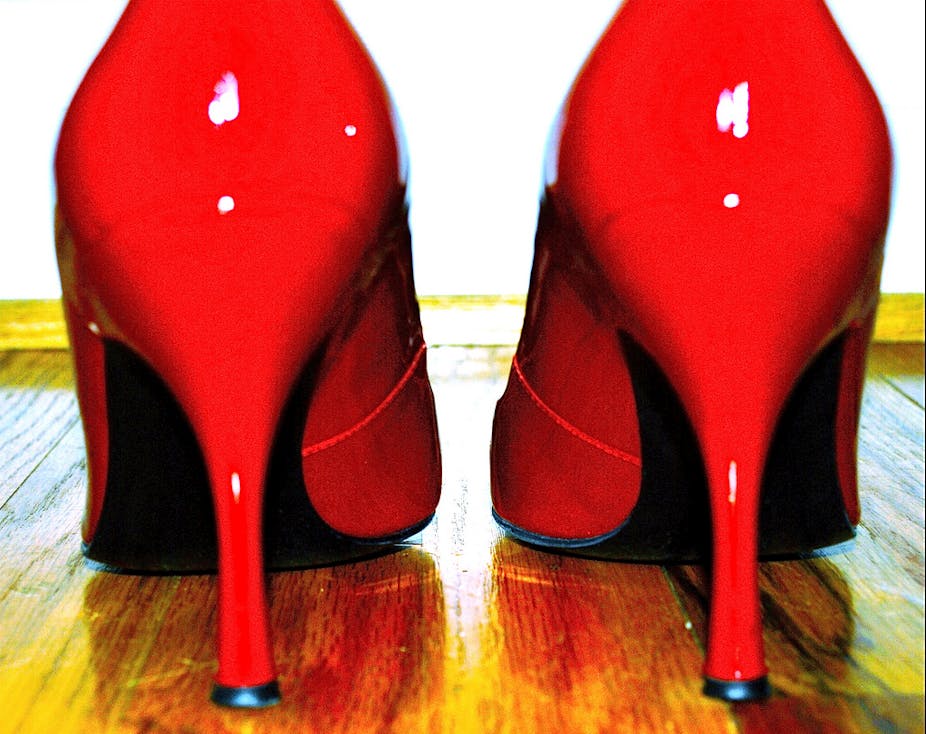Women are often told how the very high-heeled shoes they wear are doing them harm.
But instead of trying to make them feel guilty about their footwear, we would be better off discussing how to help women minimise the negative effects of high heels on foot health.
Same old, same old
As a researcher with a clinical background in podiatry, I’m often asked by journalists to provide comment on the “dangers” of high-heeled shoes.
Most of the time, I refer these requests to colleagues or to my professional association.
My reason for doing so is not because I disagree with the premise that wearing high heels is detrimental.
Rather, I tend to avoid these invitations because the articles that result from such exchanges are invariably sensationalist, and from a public health perspective, largely ineffective.
If the goal is to effect behavioural change in women in the interests of their foot health, articles about the dangers of high-heeled shoes inevitably fail.
These articles usually follow a fairly predictable script:
women are “warned” of the “dangers” or “risks” of wearing high heels by a well-intentioned health professional ;
the piece is accompanied by a celebrity reference – Victoria Beckham’s bunions being a popular choice;
a stock image of some extreme footwear (often red patent leather stilettos, the higher the better); and
a vox pop of an office worker who loves her Jimmy Choo’s and doesn’t want to stop wearing them even though they make her feet hurt.
Reference to an escalating “epidemic” of ankle injuries resulting from high heels is occasionally added for extra impact, although I’m yet to find a convincing peer-reviewed study to support such a claim.
So what, if anything, do these articles achieve?
Very little, I would argue, other than filling space in a newspaper on a slow news day or providing some public relations exposure for researchers, podiatry organisations or orthopaedic surgeons.
Indeed, every time this story gets a run in the media, an opportunity is lost to educate the general public about the effects of high heels – information that could be used to make informed choices about a lifestyle issue that could (potentially) have detrimental consequences.
Lack of evidence
The fundamental problem is that we simply don’t have convincing data to base bold statements about the long-term effects of high-heeled footwear.
Instead, we have to rely largely on biological plausibility as our evidence base.
Research into the effects of high heels is almost exclusively cross-sectional or retrospective, meaning that we can only look at associations, not causes.
To adequately ascertain the effect wearing high heels has on the body, we would need to follow up research participants for a very long time – decades, in fact – which would be expensive, time-consuming, and ultimately impractical.
Researchers have instead examined the effects of high heels on posture, muscle activity, balance and walking patterns, and have investigated associations with foot pain and common foot disorders, such as calluses and bunions.
These studies indicate that high heels do indeed change the alignment of the body, and alter force distribution through the foot in a manner that could, at least partly, explain the development of pain in the back, hips, knees, ankles and feet.
Women who regularly wear high heels have stiffer Achilles tendons than women who don’t, and recent evidence suggests that bunions are more common in women who previously wore high heels. But genetic predisposition is also likely to play a role.
Despite the inherent limitations in the available evidence, it seems plausible enough that wearing a shoe that lifts your heel off the ground and squeezes your toes into a very small space could make your feet hurt and increase your chances of developing problems in the future.
On balance, you’d be better off not doing this on a regular basis.
Not just health
Women wear high heels for a range of cultural, aesthetic and occupational reasons. So it’s probably futile for health professionals to advise them to completely stop wearing these shoes because of their potentially detrimental effects on musculoskeletal health.
Indeed, the late William Rossi, an expert on footwear best known for his 1976 book The Sex Life of the Foot and Shoe, referred to this as “an exercise in eternal futility”.
No number of alarmist newspaper reports is likely to have much of an effect on women’s shoe choices.
Instead, what is required is more accurate and detailed reporting of research into high-heeled shoes; an examination of the context in which women wear them and; the provision of pragmatic advice and treatment of any ensuing problems by health professionals.
In other words, what we need is a harm minimisation approach, recognising that while wearing high heels may not be ideal, regular podiatry treatment, the use of insoles to cushion the ball of the foot, and stretches to prevent calf muscle shortening may be of more use to women who choose (or are compelled) to wear them.
It certainly would do more good than lecturing them.

